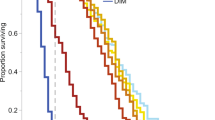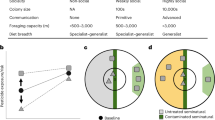Abstract
Reported widespread declines of wild and managed insect pollinators have serious consequences for global ecosystem services and agricultural production1,2,3. Bees contribute approximately 80% of insect pollination, so it is important to understand and mitigate the causes of current declines in bee populations 4,5,6. Recent studies have implicated the role of pesticides in these declines, as exposure to these chemicals has been associated with changes in bee behaviour7,8,9,10,11 and reductions in colony queen production12. However, the key link between changes in individual behaviour and the consequent impact at the colony level has not been shown. Social bee colonies depend on the collective performance of many individual workers. Thus, although field-level pesticide concentrations can have subtle or sublethal effects at the individual level8, it is not known whether bee societies can buffer such effects or whether it results in a severe cumulative effect at the colony level. Furthermore, widespread agricultural intensification means that bees are exposed to numerous pesticides when foraging13,14,15, yet the possible combinatorial effects of pesticide exposure have rarely been investigated16,17. Here we show that chronic exposure of bumblebees to two pesticides (neonicotinoid and pyrethroid) at concentrations that could approximate field-level exposure impairs natural foraging behaviour and increases worker mortality leading to significant reductions in brood development and colony success. We found that worker foraging performance, particularly pollen collecting efficiency, was significantly reduced with observed knock-on effects for forager recruitment, worker losses and overall worker productivity. Moreover, we provide evidence that combinatorial exposure to pesticides increases the propensity of colonies to fail.
This is a preview of subscription content, access via your institution
Access options
Subscribe to this journal
Receive 51 print issues and online access
$199.00 per year
only $3.90 per issue
Buy this article
- Purchase on Springer Link
- Instant access to full article PDF
Prices may be subject to local taxes which are calculated during checkout



Similar content being viewed by others
References
Biesmeijer, J. C. et al. Parallel declines in pollinators and insect-pollinated plants in Britain and the Netherlands. Science 313, 351–354 (2006)
Klein, A. M. et al. Importance of pollinators in changing landscapes for world crops. Proc. R. Soc. B 274, 303–313 (2007)
Kremen, C. et al. Pollination and other ecosystem services produced by mobile organisms: a conceptual framework for the effects of land-use change. Ecol. Lett. 10, 299–314 (2007)
Potts, S. G. et al. Global pollinator declines: trends, impacts and drivers. Trends Ecol. Evol. 25, 345–353 (2010)
Oldroyd, B. P. What's killing American honey bees? PLoS Biol. 5, e168 (2007)
Brown, M. J. F. & Paxton, R. J. The conservation of bees: a global perspective. Apidologie 40, 410–416 (2009)
Thompson, H. M. Behavioural effects of pesticides in bees - their potential for use in risk assessment. Ecotoxicology 12, 317–330 (2003)
Desneux, N., Decourtye, A. & Delpuech, J. M. The sublethal effects of pesticides on beneficial arthropods. Annu. Rev. Entomol. 52, 81–106 (2007)
Cresswell, J. E. A meta-analysis of experiments testing the effects of a neonicotinoid insecticide (Imidacloprid) on honey bees. Ecotoxicology 20, 149–157 (2011)
Schneider, C. W., Tautz, J., Grünewald, B. & Fuchs, S. RFID tracking of sublethal effects of two neonicotinoid insecticides on the foraging behavior of Apis mellifera. PLoS ONE 7, e30023 (2012)
Henry, M. et al. A common pesticide decreases foraging success and survival in honey bees. Science 336, 348–350 (2012)
Whitehorn, P. R., O'Connor, S., Wackers, F. L. & Goulson, D. Neonicotinoid pesticide reduces bumble bee colony growth and queen production. Science 336, 351–352 (2012)
Johnson, R. M., Ellis, M. D., Mullin, C. A. & Frazier, M. Pesticides and honey bee toxicity — USA. Apidologie 41, 312–331 (2010)
Mullin, C. A. et al. High levels of miticides and agrochemicals in North American apiaries: implications for honey bee health. PLoS ONE 5, e9754 (2010)
Krupke, C. H., Hunt, G. J., Eitzer, B. D., Andino, G. & Given, K. Multiple routes of pesticide exposure for honey bees living near agricultural fields. PLoS ONE 7, e29268 (2012)
Johnson, R. M., Pollock, H. S. & Berenbaum, M. R. Synergistic interactions between in-hive miticides in Apis mellifera. J. Econ. Entomol. 102, 474–479 (2009)
Pilling, E. D. & Jepson, P. C. Synergism between EBI fungicides and a pyrethroid insecticide in the honeybee (Apis mellifera). Pestic. Sci. 39, 293–297 (1993)
Elbert, A., Haas, M., Springer, B., Thielert, W. & Nauen, R. Applied aspects of neonicotinoid uses in crop protection. Pest Manag. Sci. 64, 1099–1105 (2008)
Rortais, A., Arnold, G., Halm, M. P. & Touffet-Briens, F. Modes of honeybees exposure to systemic insecticides: estimated amounts of contaminated pollen and nectar consumed by different categories of bees. Apidologie 36, 71–83 (2005)
Chauzat, M. P. et al. A survey of pesticide residues in pollen loads collected by honey bees in France. J. Econ. Entomol. 99, 253–262 (2006)
Blacquière, T., Smagghe, G., van Gestel, C. A. M. & Mommaerts, V. Neonicotinoids in bees: a review on concentrations, side-effects and risk assessment. Ecotoxicology 21, 973–992 (2012)
Molet, M., Chittka, L., Stelzer, R. J., Streit, S. & Raine, N. E. Colony nutritional status modulates worker responses to foraging recruitment pheromone in the bumblebee Bombus terrestris. Behav. Ecol. Sociobiol. 62, 1919–1926 (2008)
Schmid-Hempel, R. & Schmid-Hempel, P. Colony performance and immunocompetence of a social insect, Bombus terrestris, in poor and variable environments. Funct. Ecol. 12, 22–30 (1998)
Pelletier, L. & McNeil, J. N. The effect of food supplementation on reproductive success in bumblebee field colonies. Oikos 103, 688–694 (2003)
Thompson, H. & Wilkins, S. Assessment of the synergy and repellency of pyrethroid/fungicide mixtures. Bull. Insectol. 56, 131–134 (2003)
Bortolotti, L. et al. Effects of sub-lethal imidacloprid doses on the homing rate and foraging activity of honey bees. Bull. Insectol. 56, 63–67 (2003)
Decourtye, A., Devillers, J., Cluzeau, S., Charreton, M. & Pham-Delègue, M. H. Effects of imidacloprid and deltamethrin on associative learning in honeybees under semi-field and laboratory conditions. Ecotoxicol. Environ. Saf. 57, 410–419 (2004)
Mommaerts, V. et al. Risk assessment for side-effects of neonicotinoids against bumblebees with and without impairing foraging behavior. Ecotoxicology 19, 207–215 (2010)
Yang, E. C., Chuang, Y. C., Chen, Y. L. & Chang, L. H. Abnormal foraging behavior induced by sublethal dosage of Imidacloprid in the Honey bee (Hymenoptera: Apidae). J. Econ. Entomol. 101, 1743–1748 (2008)
Halm, M. P., Rortais, A., Arnold, G., Taséi, J. N. & Rault, S. New risk assessment approach for systemic insecticides: the case of honey bees and imidacloprid (Gaucho). Environ. Sci. Technol. 40, 2448–2454 (2006)
Thompson, H. M. Assessing the exposure and toxicity of pesticides to bumblebees (Bombus sp.). Apidologie 32, 305–321 (2001)
Brittain, C. & Potts, S. G. The potential impacts of insecticides on the life-history traits of bees and the consequences for pollination. Basic Appl. Ecol. 12, 321–331 (2011)
Garthwaite, D., Thomas, M. R., Parrish, G., Smith, L. & Barker, I. Pesticide Usage Survey Report 224. Arable Crops in Great Britain 2008 (Including Aerial Applications 07–08) (Food and Environmental Research Agency, 2008)
Garthwaite, D. et al. Pesticide Usage Survey Report 235. Arable Crops in UK 2010 (Including Aerial Applications 2010) (Food and Environmental Research Agency, 2010)
Bonmatin, J. M. et al. A LC/APCI-MS/MS method for analysis of imidacloprid in soils, in plants, and in pollens. Anal. Chem. 75, 2027–2033 (2003)
Bonmatin, J. M. et al. Quantification of imidacloprid uptake in maize crops. J. Agric. Food Chem. 53, 5336–5341 (2005)
Chauzat, M. P. et al. Influence of pesticide residues on honey bee (Hymenoptera: Apidae) colony health in France. Environ. Entomol. 38, 514–523 (2009)
Krischik, V. A., Landmark, A. L. & Heimpel, G. E. Soil-applied imidacloprid is translocated to nectar and kills nectar-feeding Anagyrus pseudococci (Girault) (Hymenoptera: Encyrtidae). Environ. Entomol. 36, 1238–1245 (2007)
Raine, N. E. & Chittka, L. The correlation of learning speed and natural foraging success in bumble-bees. Proc. R. Soc. B 275, 803–808 (2008)
Goulson, D. Bumblebees: Behaviour, Ecology and Conservation. (Oxford Univ. Press, 2010)
Acknowledgements
We thank M.J.F. Brown, M. Clook, J. Culverhouse, A. Dixon, M. Fürst, D. Garthwaite, A. Horsell, V. Jansen and I. Pedroso-Rovira for comments and technical assistance, and Syngenta Bioline Bees for supplying colonies. The study was supported by the Insect Pollinator Initiative (funded under the auspices of the Living with Environmental Change programme, Biotechnology and Biological Sciences Research Council (BBSRC), Wellcome Trust, Scottish Government, Department for Environment, Food and Rural Affairs (DEFRA) and Natural Environment Research Council (NERC): grant BB/I000178/1).
Author information
Authors and Affiliations
Contributions
R.J.G., O.R.-R. and N.E.R. carried out the experiment; R.J.G. and N.E.R. designed the experiment and wrote the paper; N.E.R. conceived the project.
Corresponding authors
Ethics declarations
Competing interests
The authors declare no competing financial interests.
Supplementary information
Supplementary Information
This file contains Supplementary Methods, Supplementary Analyses and Results, Supplementary References, Supplementary Figures 1-8, Supplementary Tables 1-2 and Supplementary Box 1. (PDF 1495 kb)
Rights and permissions
About this article
Cite this article
Gill, R., Ramos-Rodriguez, O. & Raine, N. Combined pesticide exposure severely affects individual- and colony-level traits in bees. Nature 491, 105–108 (2012). https://doi.org/10.1038/nature11585
Received:
Accepted:
Published:
Issue Date:
DOI: https://doi.org/10.1038/nature11585
This article is cited by
-
Empirical studies of integrated pest and pollinator management (IPPM) in chickpea (Cicer arietinum L.)
Journal of Plant Diseases and Protection (2024)
-
Oral exposure to thiacloprid-based pesticide (Calypso SC480) causes physical poisoning symptoms and impairs the cognitive abilities of bumble bees
BMC Ecology and Evolution (2023)
-
Implementing IPM in crop management simultaneously improves the health of managed bees and enhances the diversity of wild pollinator communities
Scientific Reports (2023)
-
Neither sulfoxaflor, Crithidia bombi, nor their combination impact bumble bee colony development or field bean pollination
Scientific Reports (2023)
-
Gene expression in bumble bee larvae differs qualitatively between high and low concentration imidacloprid exposure levels
Scientific Reports (2023)
Comments
By submitting a comment you agree to abide by our Terms and Community Guidelines. If you find something abusive or that does not comply with our terms or guidelines please flag it as inappropriate.



